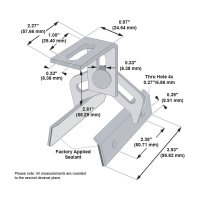
Solar power isn't a perfect fit for every type of home. A recent family adventure took me to the mountains of Kentucky where the use of solar is starting to really catch on. Many of the installs I observed were in areas where utility power is hard to reach, some more remote than others. So what does the inventive homeowner do when burning fossil fuel is costly to them and certainly not as good for the environment? Install some PV modules of course!
I took note of some installs, which were very ghastly. Wire strewn over the roof peaks, very questionable mounting methods and some roofing that could probably recall the moon landings. So, the purpose of this prose today is how to prepare your roof for the installation of PV modules. Ideally, one side of the roof must face the south (but remember this ditty “east the least, west is best” when south isn’t a viable option for you). The roof's pitch must be at an angle that presents optimal exposure to sunlight. If this is not the case you may opt to have your arrays tilted. Preparing your roof for solar modules means removing every possible barrier to the installation. The homeowner or a certified professional must get onto the roof for a thorough inspection, and then perform the appropriate maintenance and adjustments before the solar modules can be installed.
Firstly, inspect your roof or call roofing professional to inspect your roof. Scan for damaged shingles and potential leaks. Repair any problems, or install a whole new roof if necessary. Most solar modules are designed to work for 20 to 25 years, and the roof will need to last that long as well.
Examine the trees that overhang or cast a shadow on the house. Trim away any limbs that shade the area of the roof that will be occupied by the solar array. Contact a professional to handle large branches or tree removal, if needed.
Locate new positions for the roof vents, antennas, satellite dishes and any other roof fittings that may be in the way of the proposed solar array. Building codes may require that relocation of some roof vents can only be performed by a licensed plumbing contractor.
Measure the area of your roof. Begin at the eaves and measure the length of the roof and its width. Multiply these numbers to determine the area of the roof. The area that is needed will depend upon how large the system may need to be to offset your utility bill. Say for example you require 45kWh a day on average and you are lucky to get about 5 hours of good sunlight, you would require about a 9kW PV system. Using that figure and a module with about 18 sqft of area at 325W each you would need about 500 sqft of roof area.
Now that you have sorted through all of that, next you may contact a structural engineer, architect or other certified building professional to confirm that your roof can accommodate the added load and stress of the solar modules and racking. Typically, this figure is between 3 - 5 psf, which most roofs can probably accommodate, but it is a good idea to check first.
